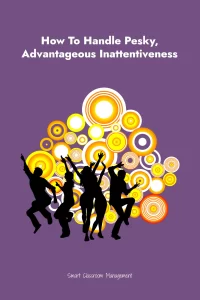
You have good classroom management.
Your students like and respect you. They follow your directions and are attentive while you’re speaking.
Yet, the second you look away, even for a brief moment, you lose them and the momentum of your lesson. You’re able to bring them back, but it’s still frustrating.
It wastes time. They can do better.
The truth is, whenever you pause your teaching to grab something from a cabinet, enter attendance, or look down at your document camera, students are prone turn their attention.
It’s human nature. You see, whenever our attention is broken unexpectedly, we seek stimulation elsewhere. Think of being in a movie theater when the projector breaks.
This is why students start turning and looking around so quickly. They make eye contact with friends. They motion to each other. They side-talk or stare out the window.
So what’s the solution?
The solution is to bring the issue out into the open. Unplanned pauses during lessons are going to happen. When they do, your students need to know exactly what is and isn’t okay.
This doesn’t necessarily mean that they have to sit and stare at you. But they do need to know that unless you say, “This is going to take a minute, go ahead and talk,” they must wait patiently.
As part of your explanation, model common examples so they can recognize when it happens. Then, of course, you must test them.
While teaching per usual, periodically fake having to look inside your desk, fiddle with the electrical plug, or find the right page.
If you do have good classroom management, the problem will disappear. Again, it seems obvious that students would know this. But they don’t.
You have to teach them.
To ensure the lesson is clear, you may want to be sneaky for a few days. Bluff, pretend, act as if you’re lost in thought or your attention is elsewhere and see if anyone side-talks.
This will strengthen their new habit, build academic discipline, and increase their ability to focus for longer and longer periods of time.
If a student does turn to talk to a neighbor during an unexpected break, then simply enforce a consequence.
PS – If teaching has become stressful for you, check out my new book Unstressed: How to Teach Without Worry, Fear, and Anxiety.
Also, if you haven’t done so already, please join us. It’s free! Click here and begin receiving classroom management articles like this one in your email box every week.

It is so courageous and educative thank you
Great technique! Thanks for sharing.
This is exactly my problem. Can you suggest an appropriate consequence for this behavior to nip it in the bud at the start of the school year?
I clearly have not managed this well and I am paying for it.
I think the idea is to follow your typical ladder of consequences. So, you start with “this is your warning for talking during the lesson.” What comes next should be grade appropriate. For my high schoolers, they have a conversation with me after class. If it keeps happening, I assign something related to the behavior I want them to fix. And then if it keeps happening I call home, and let home know that the next step will be referral to administration.
I’m a 4th grade teacher and when Im on outside recess duty, my students who got in trouble get a ‘mundane obstacle course recess detention’.
This means, they can’t play with their friends for a set amount of time. Instead, they can only do the physical obstacle course that I prescribe. E.g., walking or skipping around the outskirts of the playground a set number of times (or for a set number of minutes), a few jumping jacks, run and touch certain walls, benches, etc. in the prescribed play area. This way they still get physical activity during their break, but not with free choice playimg with friends as they would like. At first, they’ll think it’s fun, but after a while they regret not being able to play outside with friends as they wish.
Just curious if this a school wide thing, or just for your classroom?
Bill
Several things: 1. Have a back up plan. If something goes wrong with tech, equipment, papers, wifi…have a back up to go to right away.
2. Give clear directions of what you the kids to do if something goes wrong, this was mentioned in the article, but plan this out ahead of time.
3. Keep your cool: don’t get flustered, go to back up plan #1, #2, #3.
4. Get to your classroom early and PLAN for things to go wrong. Find the stress points in your lesson where there could be breakdowns.
When I was in 6th grade a long long time ago, the consequence for sidetalk was to write what we called “lines”. The teacher would have you write “I will not talk in class”. You had to write it 25 times on a piece of lined paper.
We hated and feared writing lines. I can vividly remember doing it. I assume it was somewhat effective as a deterrent.
I’m a sub in the suburbs. K-8. I wish I could impose the consequence of writing “I will not talk in class” 25 times. Actually, I’d be OK with 10 times. Whether or not it deterred, it would nevertheless provide a sense of justice to those who didn’t sidetalk.
PS– At the MS level, I have very little tolerance for sidetalk. Typically I give one warning and than move them to a different desk. But this couldn’t work in grade school, where there desks are personal, with papers/books stored within.